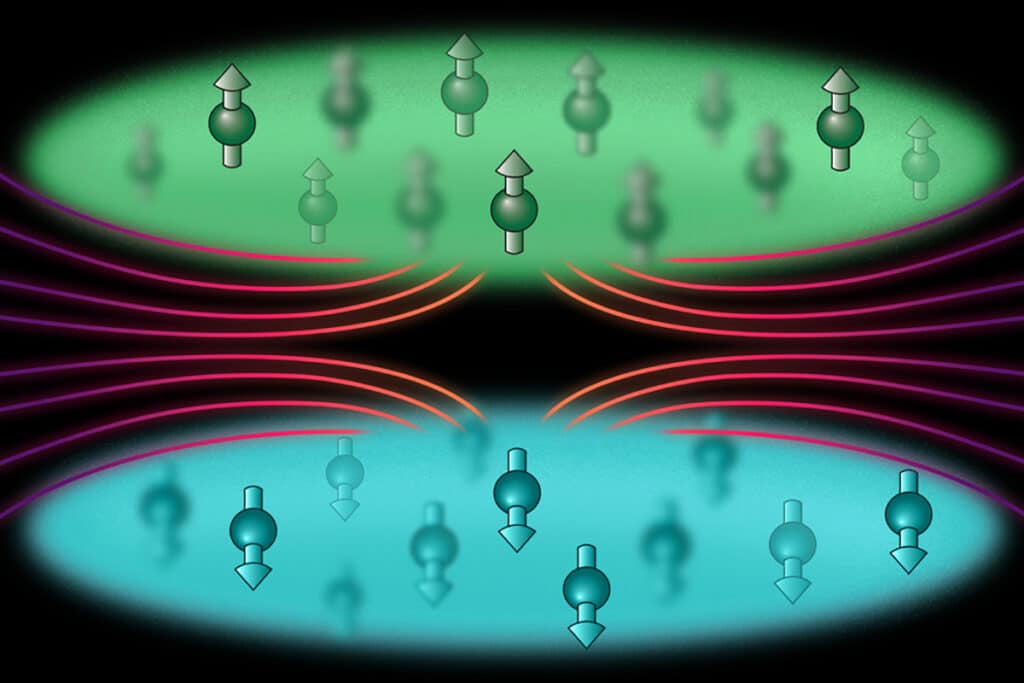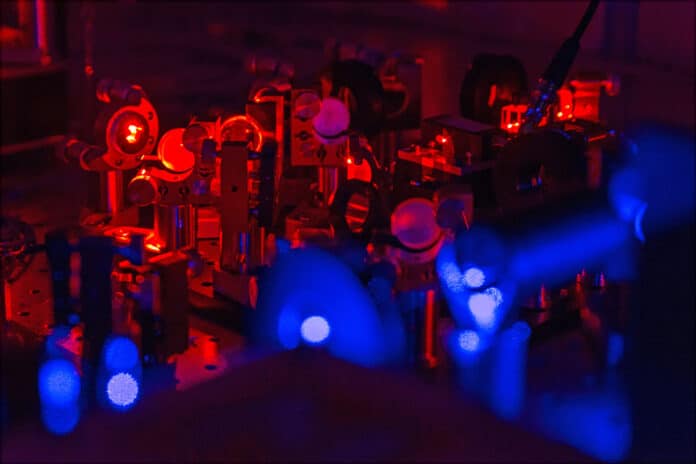Since the interactions between atoms are more significant when the particles are near each other, proximity is essential for many quantum phenomena. Scientists arrange atoms as closely as possible in various quantum simulators to create new quantum materials and investigate unusual states of matter.
Usually, they accomplish this by chilling the atoms to a standstill and then positioning the particles as close together as possible, up to a maximum of 500 nanometers, depending on the light’s wavelength. Now, scientists at MIT have created a method that enables them to arrange atoms far closer together—down to only 50 nanometers. A red blood cell’s width is roughly 1,000 nanometers, for reference.
The physicists showcased their novel method with experiments using the most magnetic atom in nature, dysprosium. Using the novel method, they manipulated two layers of dysprosium atoms, positioning the layers exactly 50 nanometers apart. The magnetic interactions were 1,000 times greater at this extreme proximity than if the layers were 500 nanometers apart.
Additionally, the scientists were able to quantify two novel effects brought on by the atoms’ close proximity. In addition to synchronized oscillations across layers, their increased magnetic forces resulted in “thermalization,” or heat transfer from one layer to another. As the layers got farther apart, these impacts diminished.
Wolfgang Ketterle, the John D. MacArthur Professor of Physics at MIT, said, “We have gone from positioning atoms from 500 nanometers to 50 nanometers apart, and there is much you can do with this. At 50 nanometers, the behavior of atoms is so much different that we’re entering a new regime here.”
Scientists say this new approach can be applied to many other atoms to study quantum phenomena. Now, the team plans to use the technique to manipulate atoms into configurations that could generate the first purely magnetic quantum gate — a fundamental building block for a new quantum computer.

Scientists usually begin by cooling a cloud of atoms to temperatures close to absolute zero to manage and arrange them. Then, they corral the atoms into an optical trap using a system of laser beams.
An electromagnetic wave with a particular wavelength—the separation between the electric field’s maxima—and frequency makes up laser light. The wavelength sets the so-called optical resolution limit, or the most miniature pattern into which light may be formed, at around 500 nanometers. Atoms will be located at the laser’s highest intensity spots because specific frequencies of laser light attract atoms. Because of this, the ability to position atomic particles at close range has been restricted by current approaches, making it impossible to investigate phenomena that occur at much shorter distances.
Ketterle said, “Conventional techniques stop at 500 nanometers, limited not by the atoms but by the wavelength of light. We have found now a new trick with light where we can break through that limit.”
Like existing methods, the team’s new strategy begins by cooling a cloud of atoms to a temperature of approximately one microkelvin, which is only a little bit over absolute zero. At this point, the atoms approach a near-standstill. Physicists can then manipulate the frozen particles using lasers to achieve the desired configurations.
Scientists then worked with two laser beams, each with a different frequency, color, and circular polarization or direction of the laser’s electric field.
Atoms in a supercooled cloud of atoms can align their spin in opposing directions, following the polarization of either lasers when the two beams pass over it. Two groups of the same atoms, but with different spins, are produced due to the beams. With a spatial period of 500 nanometers, each laser beam created a standing wave, a periodic pattern of electric field intensity.
Depending on the atoms’ spin, each standing wave attracted and contained one of two groups of atoms due to their distinct polarizations. Atoms gravitating toward the peaks of each laser could be separated by the same 50 nanometers if the lasers were tuned and superimposed to have a separation between their peaks of only 50 nanometers.
However, for this to occur, the lasers must be incredibly stable and impervious to any outside noise, such as vibrations or even breathing throughout the experiment. By guiding the two lasers over an optical fiber, the team could lock the light beams in place with respect to one another and steady both lasers.
Du said, “The idea of sending both beams through the optical fiber meant the whole machine could shake violently, but the two laser beams stayed stable concerning each others.”
The team employed atoms of dysprosium, a rare-earth metal that is one of the elements in the periodic table with the highest magnetic properties, especially at ultracold temperatures, as a test subject for their novel technique. Even at 500 nanometers, the element’s magnetic interactions are comparatively weak at the atomic scale. The scientists reasoned that if their new method could space dysprosium atoms as close as 50 nanometers apart, they might see the emergence of otherwise weak interactions between the magnetic particles. As with ordinary refrigerator magnets, the magnetic attraction between atoms increases with proximity.
Ketterle says, “We could suddenly have magnetic interactions, which used to be almost negligible but now are strong.”
Using this method, the scientists divided the dysprosium atoms into two spin groups, or layers, by first supercooling the atoms and then letting two lasers pass through. After stabilizing the lasers with an optical fiber, they discovered that the two layers of dysprosium atoms did gravitate toward their respective laser peaks. This resulted in a separation of the atom layers of 50 nanometers, the closest distance achieved by any ultracold atom experiment to date.
The atoms’ inherent magnetic connections were greatly strengthened at this incredibly tight distance, 1,000 times stronger than they would have been at 500 nanometers. As a result of these interactions, the team observed two new quantum phenomena: thermalization, in which heat was transferred from one layer to another solely through magnetic fluctuations in the atoms, and collective oscillation, in which the vibrations of one layer caused the vibrations of the other layer to vibrate in unison.
Du said, “Until now, heat between atoms could only be exchanged when they were in the same physical space and could collide,” Du notes. “Now we have seen atomic layers, separated by vacuum, and they exchange heat via fluctuating magnetic fields.”
We are bringing super-resolution methods to the field, and it will become a general tool for quantum simulations,” Ketterle says. “There are many variants possible, which we are working on.”
Journal Reference:
- Li Du, Pierre Barral, Michael Cantara et al. Atomic physics on a 50-nm scale: Realization of a bilayer system of dipolar atoms. Science. DOI: 10.1126/science.adh3023
